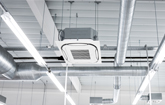US HVAC Market Forecasts by Product, Energy Source, Market and Region
Replacement of Aging Equipment to Remain the Key Driver of Growth
NEW YORK, Oct. 30, 2017 /PRNewswire/ -- The majority of expected demand increases will come from ongoing replacement of existing equipment that has reached the end of its operational lifespan with better performing, and typically higher value, equipment.
Read the full report: https://www.reportlinker.com/p05166513
Shifts in the product mix toward more expensive HVAC equipment -- such as away from room air conditioners to unitary air conditioners and from noncondensing cast iron boilers to condensing steel boilers -- will provide further impetus to dollar gains.
Key Findings in US HVAC Market Forecasts:
Air Conditioning Equipment to Continue to Account for the Largest Share of Demand
Air conditioning equipment is expected to remain the leading product type in value terms in 2021.
The relatively higher price of air conditioning equipment and a substantial replacement market is responsible for the equipment's large market size.
Through 2021, sales advances for air conditioning equipment will approximate the average for HVAC equipment overall.
Heating Equipment to Post the Fastest Increases of Any Product Type
Sales growth for heating equipment, which represents the second leading HVAC equipment product type, will outpace growth for all other product categories through 2021.
Rising demand for better performing and higher value equipment will drive advances.
In addition, the need to promptly replace heating equipment upon unit failure supports overall equipment sales levels.
Residential Market to Remain the Faster Growing
The residential market for HVAC equipment is expected to outperform the commercial market through 2021.
Ongoing replacement activity will remain the key factor boosting equipment sales.
Continued strength in the construction of new housing units will also have a positive impact on demand, as will the larger size of the installed equipment base from earlier home construction spending.
However, the residential market will remain the smaller market overall due to the higher heating and cooling requirements of larger commercial buildings, which typically results in the use of more expensive units and the installation of more than one unit in many commercial facilities.
The South Will Remain the Largest Market
The South accounts for the largest share of US HVAC equipment demand in any given year, with regional sales accounting for 40% of total sales in 2016.
The South has the largest population and building stock of any region, resulting in a substantial replacement market that supports overall HVAC equipment sales.
Through 2021, the South and West are forecast to experience the strongest gains in sales in percentage terms, a byproduct of the regions' large and growing populations and building stocks.
Study Coverage
This industry study presents historical demand data (2006, 2011, and 2016) and forecasts (2021) by product type (air conditioning equipment, dehumidifiers & humidifiers, heat pumps, and heating equipment), energy source (electricity, natural gas, heating oil and other), market (commercial and residential), and US region (Midwest, South, Northeast, and West).
Demand is presented in both dollars and units.
The study also evaluates company market share and provides a competitive analysis of leading manufacturers, including Daikin Industries, Ingersoll-Rand, Johnson Controls, Lennox, LG Electronics, Nortek, Rheem, SPX, and United Technologies.
Read the full report: https://www.reportlinker.com/p05166513
About Reportlinker
ReportLinker is an award-winning market research solution. Reportlinker finds and organizes the latest industry data so you get all the market research you need - instantly, in one place.
https://www.reportlinker.com
__________________________
Contact Clare: [email protected]
US: (339)-368-6001
Intl: +1 339-368-6001
SOURCE Reportlinker
Related Links
WANT YOUR COMPANY'S NEWS FEATURED ON PRNEWSWIRE.COM?
Newsrooms &
Influencers
Digital Media
Outlets
Journalists
Opted In



Share this article